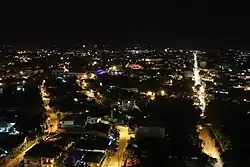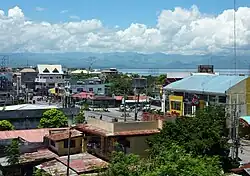Marawi
مراوي | |
|---|---|
| Islamic City of Marawi | |
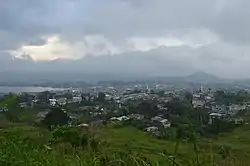 Skyline of the city as viewed in November 2018 more than a year after the Battle of Marawi | |
 Flag  Seal | |
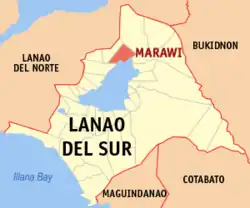 Map of Lanao del Sur with Marawi highlighted | |
OpenStreetMap | |
.svg.png.webp) Marawi Location within the Philippines | |
| Coordinates: 8°00′11″N 124°17′06″E / 8.0031°N 124.285°E | |
| Country | |
| Region | |
| Province | Lanao del Sur |
| District | 1st district |
| Settled | 1639 |
| Chartered | May 24, 1907 |
| Cityhood | August 19, 1940 |
| Renamed | June 16, 1956 |
| Barangays | 96 (see Barangays) |
| Government | |
| • Type | Sangguniang Panlungsod |
| • Mayor | Majul U. Gandamra (PMP) |
| • Deputy mayor | Anouar A. Abdulrauf (PMP) |
| • Representative | Ziaur-Rahman A. Adiong (Lakas–CMD) |
| • City Council | Members |
| • Electorate | 79,244 voters (2022) |
| Area | |
| • Total | 87.55 km2 (33.80 sq mi) |
| Elevation | 710 m (2,330 ft) |
| Highest elevation | 1,852 m (6,076 ft) |
| Lowest elevation | 19 m (62 ft) |
| Population (2020 census)[4] | |
| • Total | 207,010 |
| • Density | 2,400/km2 (6,100/sq mi) |
| • Households | 30,839 |
| Economy | |
| • Income class | 4th city income class |
| • Poverty incidence | 63.18 |
| • Revenue | ₱ 837.6 million (2020) |
| • Assets | ₱ 3,559 million (2020) |
| • Expenditure | ₱ 843.9 million (2020) |
| • Liabilities | ₱ 2,116 million (2020) |
| Service provider | |
| • Electricity | Lanao del Sur Electric Cooperative (LASURECO) |
| Time zone | UTC+08:00 (PST) |
| ZIP code | 9700 |
| PSGC | |
| IDD : area code | +63 (0)63 |
| Native languages | Maranao Tagalog |
Marawi, officially the Islamic City of Marawi (Maranao: Bandar a Marawi; Filipino: Lungsod ng Marawi), is a 4th class component city and capital of the province of Lanao del Sur, Philippines. According to the 2020 census, it has a population of 207,010 people.[4]
Marawi is located upon the shores of Lake Lanao.[6] It is primarily inhabited by the Maranao people. The city is also called the "summer capital of the south" due to its higher elevation and cooler climate,[7] a nickname it shares with Malaybalay.[8]
On May 23, 2017, the city suffered extensive damage during the Battle of Marawi as militants affiliated with the Islamic State of Iraq and the Levant invaded the city and engaged in a massive urban gunfight.[9] The ensuing battle lasted until October 23, 2017, when Defense Secretary Delfin Lorenzana announced the ending of the battle. Major damage of the city was mostly caused by airstrikes carried out by the Philippine Air Force in an attempt to eliminate the militants.
Etymology
Dansalan (Marawi's prior name) derived from the Mëranaw word "dansal", which means rendezvous; literally, it also means arrival[10] (in other source,[11] "where the waves come to shore"). Being known as the destination point for arriving boats,[11] the place refers to a port,[12] hence, the "Place of Destination and Purpose."[13]
Meanwhile, Marawi is derived from the word "rawi", which means reclining, in reference to Agus River.[10] On the other hand, this present name is in honor of the city's martyred hero in Kuta Maraghui (Fortress of Marawi) in 1895.[11]
History

As Dansalan
Dansalan began as a port area.[11]
.jpg.webp)
Around the original Meranaw fortification, Spanish captain Francisco Atienza founded a settlement called Dansalan in October 1639. His forces had come from Iligan and were attempting to conquer the entire Lake Lanao area. However, it was abandoned later the same year when thousands of Meranaw soldiers invested the then-fortifying settlement, pressing the Spaniards hard and thus they returned to Iligan, having failed in their quest.[12]
The Spaniards only returned to the area when they began the conquest of the Sultanate of Maguindanao in the 19th century.[12] They made attempts to capture fort Marahui, the stronghold of the Maranao, twice until they succeeded in 1895 with the deaths of Datu Amai Pakpak and Datu Sinal.[14] They abandoned the place again upon the arrival of the Americans in the country in 1898.[12][14]
Dansalan was created as a municipality by the Moro Province legislative council on May 24, 1907;[13][15] served as the capital of the undivided Lanao province since its declaration by the American Colonial Government.[10][11]
A sovereign of Marawi before 1639 was "Datu Buadi Sa Kayo" who imposed taxation.
It was in this municipality when, on March 18, 1935, a group of 189 Maranao leaders and its leader, Hadji Abdulhamid Bongabong of Unayan, signed a document known as the Dansalan Declaration, urging then United States President Franklin Roosevelt and its Congress to grant Mindanao and Sulu separate independence by the US instead of inclusion in the country's independence.[14][16]
Cityhood (1940), renaming as Marawi (1956), and later developments
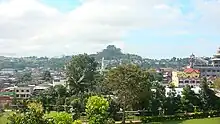
Dansalan was the last to become a chartered city under the country's Commonwealth era with the approval of Commonwealth Act No. 592 on August 19, 1940.[11][17] During World War II, the Japanese invaded Dansalan and established a "comfort station" in the city, where local girls, teenagers, and young adults were kidnapped and turned into sex slaves under brutal "comfort women" system, where victims were routinely gang-raped and killed by Japanese soldiers.[18][19][20] After the Second World War, inauguration took place on September 30, 1950.[21] It was renamed Marawi City on June 16, 1956 through Republic Act (RA) No. 1552 which amended the charter.[11][22][10][13]
Upon division of Lanao province through RA No. 2228 in 1959, it was made capital of Lanao del Sur.[11][23]
The city, being the country's only predominantly Muslim chartered city, was declared "Islamic City of Marawi" through City Council Resolution No. 19-A on April 15, 1980.[10][11][13] This was proposed by Parliamentary Bill No. 261 in the defunct Batasang Pambansa, the country's former parliament during the Marcos regime, reportedly to attract funds from the Middle East.[7]
Siege of Marawi (2017)
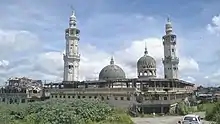
On May 23, 2017, a pro–Islamic State of Iraq and the Levant group called the Maute group attacked the city. The battle of Marawi—also known as the Marawi siege, the Marawi clash, and the Marawi crisis—started on May 23. CNN Philippines reported that the militants had over 500 men.[24] Philippine President Rodrigo Duterte declared martial law on the island of Mindanao, where the fighting was taking place, initially until December 31, 2017,[25] but was later extended to the end of 2018 and then again to the end of 2019.[25][26] The city was liberated from militant control on October 17, 2017 and battle operations officially ended on October 23, 2017.
Post-battle period
On January 30, 2018, it was announced that a 10-hectare military base will be established in the city to prevent the reentry of terrorists.[27]
2023 creation of additional barangays
On March 18, 2023, the Commission on Elections (COMELEC) held plebiscites in the city to create two barangays. The plebiscites for the establishment of Boganga II out of Boganga (City Ordinance 07-010 series of 2022), and Datu Dalidigan out of Sagonsongan (City Ordinance 05-010 series of 2022), marked the first exclusively local electoral exercise in the city post-siege.[28][29]
The plebiscites were held in two barangays, a school in each, with 5 polling precincts.[30] With 96.88% of registered voters participated, majority of them later separately ratified both city ordinances.[31][32]
| Choice | Votes | % |
|---|---|---|
| 948 | 99.79 | |
| No | 2 | 0.21 |
| Total votes | 950 | 100.00 |
| Registered voters/turnout | 992 | 95.77% |
| Source: COMELEC via Rappler news article. | ||
| Choice | Votes | % |
|---|---|---|
| 473 | 99.37 | |
| No | 3 | 0.63 |
| Total votes | 476 | 100.00 |
| Registered voters/turnout | 480 | 99.17% |
| Source: COMELEC via Rappler news article. | ||
Meanwhile, COMELEC explained that these new villages, whose creation is expected to be done in the later months, will not be contested in the Barangay and Sangguniang Kabataan elections in October.[33]
Geography
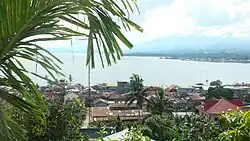
Marawi has a total land area of 8,755 hectares (21,630 acres). [34] It is located on the northernmost shores of Lake Lanao and straddles the area where the Agus River starts. It is bounded to the north by the municipalities of Kapai and Saguiaran; to the south by Lake Lanao; to the east by the municipalities of Bubong and Ditsaan-Ramain; and to the west by the municipalities of Marantao and Saguiaran.[7] The Bagang beach is situated 2 kilometers (1.2 mi) from the city's commercial center.
The Muslim majority city also hosts a national park, the Sacred Mountain National Park, which spans the barangays of Guimba and Papandayan covering an area of 94-hectare (230-acre). The protected area was established on August 5, 1965, by Republic Act no. 4190.[35] The park is dominated by Mount Mupo, a 900-foot (270 m) tall[36] extinct volcanic cone. The park is ideal for birdwatching and mountain climbing to the summit that features a small pond.[37]
Topography
Mountains, rolling hills, valleys, and a large placid lake dominate the city's landscape. Angoyao Hills (Barangay Sogod) served as natural viewpoint over the water of the Lake Lanao. Signal Hill (Barangay Matampay), Arumpac Hill (Barangay Saduc), and Mt. Mupo (Barangay Guimba) are considered beautiful but mysterious. Mt. Mupo, located within the Sacred Mountain National Park, is known for its untouched trees and beautiful, perfect cone.
Barangays
Marawi is politically subdivided into 98 barangays.[32][38] Each barangay consists of puroks while some have sitios.
- Ambolong
- Bacolod Chico Proper
- Banga
- Bangco
- Banggolo Poblacion
- Bangon
- Biaba-Damag
- Bito Buadi Itowa
- Bito Buadi Parba
- Bubonga Pagalamatan
- Bubonga Lilod Madaya
- Boganga
- Boganga II
- Boto Ambolong
- Bubonga Cadayonan
- Bubong Lumbac
- Bubonga Marawi
- Bubonga Punod
- Cabasaran
- Cabingan
- Cadayonan
- Cadayonan II
- Calocan East
- Calocan West
- Kormatan Matampay
- Daguduban
- Dansalan
- Datu Dalidigan
- Datu Saber (Navarro)
- Datu Sa Dansalan
- Dayawan
- Dimaluna
- Dulay
- Dulay West
- East Basak
- Emie Punud
- Fort
- Gadongan
- Buadi Sacayo (Green)
- Guimba (Lilod Proper)
- Kapantaran
- Kilala
- Lilod Madaya (Poblacion)
- Lilod Saduc
- Lomidong
- Lumbaca Madaya (Poblacion)
- Lumbac Marinaut
- Lumbaca Toros
- Malimono
- Basak Malutlut
- Gadongan Mapantao
- Amito Marantao
- Marinaut East
- Marinaut West
- Matampay
- Pantaon (Langcaf)
- Mipaga Proper
- Moncado Colony
- Moncado Kadingilan
- Moriatao Loksadato
- Datu Naga
- Olawa Ambolong
- Pagalamatan Gambai
- Pagayawan
- Panggao Saduc
- Papandayan
- Papandayan Caniogan
- Paridi
- Patani
- Pindolonan
- Poona Marantao
- Puga-an
- Rapasun MSU
- Raya Madaya I
- Raya Madaya II
- Raya Saduc
- Rorogagus Proper
- Rorogagus East
- Sabala Manao
- Sabala Manao Proper
- Saduc Proper
- Sagonsongan
- Sangcay Dansalan
- Somiorang
- South Madaya Proper
- Sugod Proper
- Tampilong
- Timbangalan
- Tuca Ambolong
- Tolali
- Toros
- Tuca
- Tuca Marinaut
- Tongantongan-Tuca Timbangalan
- Wawalayan Calocan
- Wawalayan Marinaut
- Marawi Poblacion
- Norhaya Village
Climate
| Climate data for Marawi | |||||||||||||
|---|---|---|---|---|---|---|---|---|---|---|---|---|---|
| Month | Jan | Feb | Mar | Apr | May | Jun | Jul | Aug | Sep | Oct | Nov | Dec | Year |
| Mean daily maximum °C (°F) | 24 (75) |
24 (75) |
25 (77) |
26 (79) |
26 (79) |
25 (77) |
25 (77) |
25 (77) |
25 (77) |
25 (77) |
25 (77) |
25 (77) |
25 (77) |
| Mean daily minimum °C (°F) | 20 (68) |
20 (68) |
20 (68) |
20 (68) |
21 (70) |
21 (70) |
20 (68) |
20 (68) |
20 (68) |
20 (68) |
20 (68) |
20 (68) |
20 (68) |
| Average precipitation mm (inches) | 159 (6.3) |
143 (5.6) |
166 (6.5) |
183 (7.2) |
357 (14.1) |
414 (16.3) |
333 (13.1) |
309 (12.2) |
289 (11.4) |
285 (11.2) |
253 (10.0) |
166 (6.5) |
3,057 (120.4) |
| Average rainy days | 18.4 | 17.2 | 20.6 | 23.4 | 29.3 | 29.2 | 29.9 | 29.4 | 27.7 | 28.7 | 25.5 | 19.9 | 299.2 |
| Source: Meteoblue[39] | |||||||||||||
Marawi's weather is warm and wet throughout the year. With the elevation along Lake Lanao at around 2,300 feet (700 m),[3] this raised altitude together frequent heavy showers at all seasons, ensures that hot conditions are seldom observed.
Demographics
| Year | Pop. | ±% p.a. |
|---|---|---|
| 1918 | 6,005 | — |
| 1939 | 11,319 | +3.06% |
| 1948 | 19,657 | +6.32% |
| 1960 | 27,049 | +2.70% |
| 1970 | 55,708 | +7.48% |
| 1975 | 63,332 | +2.61% |
| 1980 | 53,812 | −3.20% |
| 1990 | 91,901 | +5.50% |
| 1995 | 114,389 | +4.19% |
| 2000 | 131,090 | +2.96% |
| 2007 | 177,391 | +4.26% |
| 2010 | 187,106 | +1.96% |
| 2015 | 201,785 | +1.45% |
| 2020 | 207,010 | +0.50% |
| Source: Philippine Statistics Authority[40][41][42][43] | ||
Language
Maranao or Meranaw is widely spoken in Marawi; however, local inhabitants can also speak Maguindanao, Iranun, English and Tagalog.
Religion
.jpg.webp)
Marawi is predominantly a Muslim city, with Muslims accounting for 99.6% of the population.[7]
Economy
The economy of Marawi is largely based on agriculture, trading, and exporting. Most industries in the city are agriculture-oriented. They include rice and corn farming, hollow blocks manufacturing, goldsmithing, and saw milling. Small and cottage-size enterprises are engaged in garment making, mat and malong weaving, wood carving, brassware making, web development, and blacksmithing.[7]
Apart from that, Marawi is home to NPC – Agus 1 Hydro Electric Power Plant and the first of the six cascading Agus Hydro Power Plants.
A new wind and solar energy plant and a new diesel-generated power plant are set to be developed in Saguiaran, Lanao del Sur, by two private firms to provide electricity to Marawi and adjoining areas.[51][52] The project will cost PHP 2 billion and will generate 10 to 30 megawatts of electricity.[51]
Culture
.jpg.webp)
.jpg.webp)
.jpg.webp)
Architecture
The feeling of the unique natural setting of the Maranaos in Marawi is manifested by the presence of many large Torogans, an antique royal high-roofed houses with carvings designed by the Meranau, and the Sambitory Old Building in Barrio Naga in front of Tuaka Laput, Marawi.
Government
.jpg.webp)
- List of Mayors
- 1948-1953, Bato R. Ali, Sr.
- 1956-1967, Macapado Batara
- 1970-1986, Omar Dianalan
- 1986, OIC Mayor
- 1986–1989, Mahid Mutilan
- 1989–1998, Abbas Maruhom Basman
- 1998–2001, Omel Macabando Basman
- 2001–2007, Omar Solitario Ali
- 2007–2016, Fahad Salic
- 2016–present, Majul Gandamra
- Only mayors since the 1986 People Power Revolution are listed.
Education
Marawi is home to the main campus of Mindanao State University, the biggest state university in Philippines. Other institutions and colleges are well established in the city and are as follows:
- Mindanao State University – Lanao National College of Arts and Trade
- University of Muslim Mindanao
- Jamiatu Philippine Al-Islamia
- Mapandi Memorial College
- Jamiatu Marawi Al-Islamia Foundation
- Pacasum College
- Marawi Capitol College
- Lake Lanao College
- Philippine Muslim Teachers College
- Marawi Islamic College
- Senator Ninoy Aquino College Foundation
- Lanao Islamic Paramedical College Foundation
- Al-Khwarizmi International College
- Mindanao Islamic Computer College
- Datu Mala Memorial College
- Dansalan Polythechnic College
- Philippines Engineering and Agro-Industrial College
- Lanao Central College
- Khadijah Mohammad Islamic Academy
- Masiricampo Abantas Memorial Educational Center, Inc.
- Philippine Integrated College Academy Foundation Inc.
Other notable secondary schools are:
- Mindanao State University – Institute of Science Education- Science High School
- Mindanao State University – Integrated Laboratory School
- Mindanao State University – University Training Center
- Ibn Siena Integrated School Foundation
- Hadiyyah International School
- Dansalan College Foundation Inc.
- Dhayfullah Islamic Institute, Inc.
- Philippine Integrated School
- Al-Khwarizmi International College – Science Laboratory High School
- Marawi City National High School
- Dansalan National High School
- Aba Al-khail Computer School
- Masiricampo Abantas Memorial Islamic and Science Academy
TESDA is also stationed in Marawi which caters to technical training of students for the province.
Within the Mindanao State University is the Aga Khan Museum of Islamic Arts which is named in honor of Sultan Aga Khan who contributed to the realization of the museum. Historical development of the country is bank on the large space upon the conservation of cultural materials. It has huge, collection of indigenous art, displayed ethnic music tape recorded, the native folk dances from different regions of Mindanao, Sulu and Palawan, the native tools and weapons used by the Muslims and different artistic designs of houses are the main attractions of museum. Indigenous art and cultural material are being displayed.
Sister cities
- Local
See also
References
- ↑ Islamic City of Marawi | (DILG)
- ↑ "2015 Census of Population, Report No. 3 – Population, Land Area, and Population Density" (PDF). Philippine Statistics Authority. Quezon City, Philippines. August 2016. ISSN 0117-1453. Archived (PDF) from the original on May 25, 2021. Retrieved July 16, 2021.
- 1 2 ""Marawi City terrain"" (Map). Google Maps. Archived from the original on December 30, 2021. Retrieved January 27, 2012.
- 1 2 Census of Population (2020). "Bangsamoro (BARMM)". Total Population by Province, City, Municipality and Barangay. Philippine Statistics Authority. Retrieved July 8, 2021.
- ↑ "PSA Releases the 2018 Municipal and City Level Poverty Estimates". Philippine Statistics Authority. December 15, 2021. Retrieved January 22, 2022.
- ↑ "Darangen Epic of the Maranao People of Lake Lanao". UNESCO Intangible Cultural Heritage. Retrieved December 30, 2021.
- 1 2 3 4 5 "Islamic City of Marawi". armm.gov.ph. June 4, 2010. Archived from the original on January 30, 2012. Retrieved January 27, 2012.
- ↑ Beezz. "Exploring Malaybalay: The South Summer Capital of the Philippines". TriptheIslands.com. Archived from the original on September 30, 2021. Retrieved September 30, 2021.
- ↑ "Philippines: 'Battle of Marawi' Leaves Trail of Death and Destruction". Amnesty International. November 17, 2017. Archived from the original on September 30, 2021. Retrieved September 30, 2021.
- 1 2 3 4 5 "City Profile". Islamic City of Marawi. Retrieved March 19, 2023.
- 1 2 3 4 5 6 7 8 9 "A brief history: The Islamic City of Marawi". ANC-X. ABS-CBN News. January 1, 2019. Retrieved March 19, 2023.
- 1 2 3 4 Custodio, Arlo (March 25, 2019). "Marawi City as an Exponent of Maranao Culture". The Manila Times. Archived from the original on September 30, 2021. Retrieved September 30, 2021.
- 1 2 3 4 For historical background of Marawi, a Philstar.com news article cited an annual Commission on Audit report.
- "Marawi headed for economic boom before siege – COA". Philstar.com. December 4, 2017. Retrieved March 19, 2023.
- "Executive Summary (2019)" (PDF). Commission on Audit. Government of the Philippines. 2019. Retrieved March 19, 2023.
- 1 2 3 "Why Does Islamic State Target Marawi City?". Jakarta Globe. September 12, 2017. Retrieved March 19, 2023.
- ↑ Report of the Philippine Commission to the Secretary of War (Part 1 of 3). Washington, D.C.: US Government Printing Office. 1908. p. 383. Retrieved March 20, 2023.
- ↑ Dansalan Declaration:
- "Historical significance of July 4, 1946 to Moros". Inquirer.net. June 12, 2015. Retrieved March 19, 2023.
- "Bangsamoro History Month 2023: Mainstreaming the past, sustaining the feats of the peace process". BARMM website. Government of the Philippines. March 7, 2023. Retrieved March 19, 2023.
- ↑ "Commonwealth Act No. 592". Senate of the Philippines. Government of the Philippines. August 19, 1940. Retrieved March 19, 2023.
- ↑ "Philippine Survivor Recounts Her Struggle As A 'Comfort Woman' For Wartime Japan". NPR.org. NPR. Retrieved August 15, 2021.
- ↑ The Other Empire: Literary Views of Japan from the Philippines, Singapore, and Malaysia. The University of the Philippines Press. 2008. ISBN 9789715425629. Retrieved August 15, 2021.
- ↑ "Women made to be Comfort Women - Philippines". www.awf.or.jp.
- ↑ "Marawi City: The Least Populated Highly Urbanized City". Philippine Statistics Authority. September 18, 2002. Archived from the original on January 17, 2018. Retrieved September 30, 2021.
- ↑ "Republic Act No. 1552". Senate of the Philippines. Government of the Philippines. June 15, 1956. Retrieved March 19, 2023.
- ↑ "Republic Act No. 2228". Senate of the Philippines. Government of the Philippines. May 22, 1959. Retrieved March 19, 2023.
- ↑ Marcelo, Ver (May 23, 2017). "Gov't Forces, Maute Group Clash in Marawi City". CNN Philippines. Archived from the original on May 24, 2017. Retrieved May 24, 2017.
- 1 2 Santos, Eimor P. (December 13, 2017). "Congress Grants Duterte Request to Extend Mindanao Martial Law until End of 2018". CNN Philippines. Retrieved December 30, 2021.
- ↑ Cabico, Gaea Katreena (December 12, 2018). "Congress Extends Martial Law in Mindanao to End of 2019". Philstar.com. Retrieved December 30, 2021.
- ↑ Yecyec, Joey Taguba (January 30, 2018). "Gov't to Build P400-Million Military Camp in Marawi". ABS-CBN News. Archived from the original on June 12, 2018. Retrieved June 9, 2018.
- ↑ "Printing of ballots for Marawi plebiscites starts Feb. 25". Philippine News Agency. February 23, 2023. Retrieved March 18, 2023.
- ↑ "Comelec to hold plebiscites in Marawi City on March 18". Inquirer.net. March 16, 2023. Retrieved March 18, 2023.
- ↑ "Marawi City to host 1st local polls since 2017 seige". SunStar. March 17, 2023. Retrieved March 18, 2023.
- ↑ "High voter turnout seen in Marawi plebiscite". Philippine News Agency. March 18, 2023. Retrieved March 18, 2023.
- 1 2 "Marawi plebiscite: Voters say yes to creation of 2 new barangays". Rappler. March 18, 2023. Retrieved March 18, 2023.
- ↑ "Marawi set to create 2 new barangays after plebiscite". ABS-CBN News. March 18, 2023. Retrieved March 18, 2023.
- ↑ "Province: Lanao del Sur". PSGC Interactive. Quezon City, Philippines: Philippine Statistics Authority. Retrieved November 12, 2016.
- ↑ "Protected Areas in Region 12". Protected Areas and Wildlife Bureau. Archived from the original on March 21, 2012. Retrieved January 27, 2012.
- ↑ "Sacred Mountain National Park" (Map). Archived from the original on December 30, 2021. Retrieved January 27, 2012 – via Google Maps.
- ↑ "Marawi, Islamic City of". Biyahero: Philippine Travel Portal. Archived from the original on July 26, 2012. Retrieved January 27, 2012.
- ↑ "PSGC Interactive – Marawi City (Capital)". National Statistical Coordination Board. Archived from the original on November 14, 2011. Retrieved January 27, 2012.
- ↑ "Marawi City: Average Temperatures and Rainfall". Meteoblue. Archived from the original on January 19, 2019. Retrieved January 19, 2019.
- ↑ Census of Population (2015). "ARMM – Autonomous Region in Muslim Mindanao". Total Population by Province, City, Municipality and Barangay. Philippine Statistics Authority. Retrieved June 20, 2016.
- ↑ Census of Population and Housing (2010). "ARMM – Autonomous Region in Muslim Mindanao" (PDF). Total Population by Province, City, Municipality and Barangay. National Statistics Office. Retrieved June 29, 2016.
- ↑ Censuses of Population (1903–2007). "ARMM – Autonomous Region in Muslim Mindanao". Table 1. Population Enumerated in Various Censuses by Province/Highly Urbanized City: 1903 to 2007. National Statistics Office.
{{cite encyclopedia}}: CS1 maint: numeric names: authors list (link) - ↑ "Province of Lanao del Sur". Municipality Population Data. Local Water Utilities Administration Research Division. Retrieved December 17, 2016.
- ↑ "Poverty incidence (PI):". Philippine Statistics Authority. Retrieved December 28, 2020.
- ↑ "Estimation of Local Poverty in the Philippines" (PDF). Philippine Statistics Authority. November 29, 2005.
- ↑ "2003 City and Municipal Level Poverty Estimates" (PDF). Philippine Statistics Authority. March 23, 2009.
- ↑ "City and Municipal Level Poverty Estimates; 2006 and 2009" (PDF). Philippine Statistics Authority. August 3, 2012.
- ↑ "2012 Municipal and City Level Poverty Estimates" (PDF). Philippine Statistics Authority. May 31, 2016.
- ↑ "Municipal and City Level Small Area Poverty Estimates; 2009, 2012 and 2015". Philippine Statistics Authority. July 10, 2019.
- ↑ "PSA Releases the 2018 Municipal and City Level Poverty Estimates". Philippine Statistics Authority. December 15, 2021. Retrieved January 22, 2022.
- 1 2 "P2-B Power Plant to Rise in Lanao Sur". Manila Bulletin. Philippine News Agency. October 20, 2018. Archived from the original on October 24, 2018. Retrieved October 24, 2018.
- ↑ Aquino, Vick (October 20, 2018). "Marawi Tatayuan ng mga Wind, Solar-Powered Energy Plant" [Marawi to Build Wind, Solar-Powered Energy Plant]. Abante (in Filipino). Archived from the original on December 30, 2021. Retrieved October 24, 2018.
.jpg.webp)

